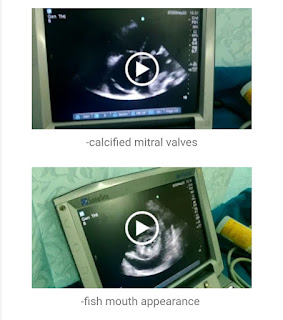MITRAL STENOSIS WITH HEART FAILURE :
5/08/22
A 55 yr old female with the complaints of palpitations,chestpain, and shortness of breath.
I have been given this case to solve in an attempt to understand the topic of ''patient clinlcal data analysis''to develop my competency in reading and comprehending clinical data including history,clinical findings,investigations and come up with a diagnosis and treatment.
Following is my analysis of this patient's problem:
The problems in order of priority i found.
CHIEF COMPLAINTS
- Palpitations(since 2 months)
- Chest pian on left side on epigastric region, nonradiating type (since 2 months)
- Shortness of breath: progressive in nature with present status grade 3-4 of dyspnea
- Paroxysmal nocturnal dyspnea (since 2 months and increased past 10 days )
- Bilateral pedal edema upto ankle ( since 1 week )
- Decreased urine output ( since 1 week )
1.PALPITATIONS
DIFFERENTIAL DIAGNOSIS OF PALPITATIONS:
- Arrhythmias (atrial fibrillations/flutter,block or sinus node dysfunction,sinus tachycardia,supra ventricular tachycardia,venticular tachycardia )
- Psychiatric causes( anxiety disorders )
- Drugs and medications ( alcohol,caffeine,digitalis,beta agonists,tobacco )
- Non arrhythmic cardiac causes( cardiomyopathy,congestive heart failure,artial or venticular septal defect,valvular disease )
- Extra cardiac causes ( anemia, fever, hyperthyroidism, hypoglycemia, pheochromocytoma. )
2. CHEST PAIN.
DIFFERENTIAL DIAGNOSIS:
- Coronary artery.
- Gastrointestinal causes.
- Musculoskeletal.
- Pericarditis.
- Pulmonary embolism.
3.DYSPNEA
DIFFERENTIAL DIAGNOSIS:
- Bronchial asthma
- COPD
- Congestive heart failure
- Interstitial lung disease
- pneumonia
- Anxiety disorders
4.PAROXYSMAL NOCTURNAL DYSPNEA
DIFFERENTIAL DIAGNOSIS:
- Acute pulmonary edema secondary to congestive heart failure
5.PEDAL EDEMA
DIFFERENTIAL DIAGNOSIS:
- Systemic illness- heart failure,liver disease,malnutrition.
- Local conditions-infection,trauma,venous thrombosis.
- Medications.
6.DIFFERENTIAL DIAGNOSIS OF LOW URINE OUTPUT:
- Dehydration.
- Urinary tract obstruction.
- Infection or trauma.
- Heart failure.
POSITIVE FINDINGS IN THE PATIENT ARE:
RESPIRATORY EXAMINATION:
- Parasternal heave felt
- wheeze heard on right side.
- breath sounds- vesicular in nature,with coarse crepitations heard (RIGHT>left)
CVS EXAMINATION:
- Pulse - irregularly irregular.
- elevated JVP with larger ''a'' component.
- inspection-normal
- palpation-apex beat=changed, down and outward (in 6th intercostal space, in anterior axillary line )
- ascultation-mitral area loud s1
- tricuspid area loud s1
- pulmonary area=splitting of s2-loud p2 component.
INVESTIGATIONS:
1.RFT
2.HEMOGRAM
3.CUE
4.CXR
5.ECG
DIAGNOSIS:MITRAL STENOSIS WITH LEFT HEART FAILURE LEADING TO RIGHT HEART FAILURE:
REASON:
1.As productive cough,wheezing,hemoptysis is absent it rules out respiratory causes
2.Chest pain and Palpitation presence indicate cardiac reason.
3.Palpitations are of 2 types paroxysmal(intermittent) and exertion(pounding)
paroxysmal leads to arrhythmias & exertional type leads to volume overload due to regurgitant lesions
-in this case arrhythmias are leading to volume overload.
4.mitral stenosis
increased left atrial pressure
increased pulmonary artery pressure
increased capillary pressure
alveoli cant open and resistance is felt
dyspnea
5.left heart failure leads to pulmonary hypertension that leads to right heart failure which in turn leads to pedal edema.
6.heart failure can be right or left
-causes for left ventricular failure are:
1.coronary heart disease
2.valvular heart disease
3.hypertension
4.cardiomyopathy
as mitral stenosis is present which is a valvular heart disease, it indicates left heart failure
7.on chest x ray - left border of heart contains aortic knuckle and convexity is present where normally concavity should present.
convexity-pulmonary artery present
-left atrial appendage is prominent.
-straightening of left border is present called mitralization
8.on palpation - apex displaced to 6th intercostal space in anterior axillary line & indicates chronic left venticular failure where Lt ventricle is dilated
9.parasternal heave is present which indicate left ventricular hypertrophy inturn leads to pulmonary artery hypertension
LEFT HEART FAILURE
1.In mitral stenosis
increase atrial pressure leads to reflex pulmonary vasoconstriction
protects patient from pulmonary edema
further increase in pulmonary vascular resistance
cause pulmonary hypertension
impairs right ventricular function.
PATHOGENESIS:
1.VENTRICULAR DYSFUNCTION.
This tells about decreased urine output in patient suffering from heart failure


2.HIGH OUTPET FAILURE:arteriovenous shunt,beri beri,anemia,thyrotoxicosis.
3.VALVULAR DISEASE
CLINICAL FEATURES OF LEFT & RIGHT HEART FAILURE
- Cardiomegaly, pulmonary oedema indicates left heart failure pulmonary oedema due to left heart failure presents with dyspnoea
- whereas right heart failure produces high JVP with hepatic congestion and dependent peripheral oedema
COMPLICATIONS OF HEART FAILURE:
- renal failure
- hyponatraemia
- impaired liver function.
- thromboembolism
- atrial & ventricular arrhythmias
- sudden death in 50% due to venticular fibrillation
MANAGEMENT:
PULMONARY EDEMA
- nitrates
- loopdiuretics
- Education-about disease
- Diet-avoidance of high salt foods
- Alcohol-eliminate consumption
- Smoking-cessation
- Vaccination-influenza & pneumococcal
DRUG TREATMENT:
- Diuretics-furosemide,thiazides
- ACE inhibitors:enalapril,lisinopril
- ARB'S-losartan,candesartan
- Beta blockers-metoprolol,bisoprolol
- Vasodilators-hydralazine
- Ivabradine
- Digoxin & amiodarone
NONPHARMACOLOGICAL TREATMENTS:
- implantable cardiac defibrilators
- resynchronization devices
- coronary revascularization
- cardiac transplantation
- ventricular assist devices.







Comments
Post a Comment